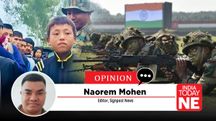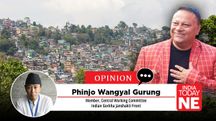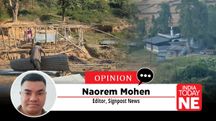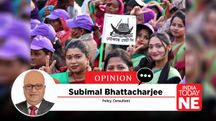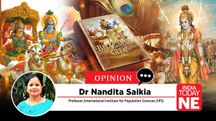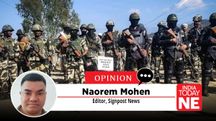Why was the Governor absent from Manipur's state-level Mera Hou Chongba Festival
Governor Ajay Kumar Bhalla’s absence from Mera Hou Chongba on October 7, 2025, stands out starkly against his enthusiastic participation in the Shirui Lily Festival earlier this year. While he skipped the event at Kangla Fort, he served as the chief guest at the Shirui Lily Festival’s inauguration on May 20 in Ukhrul. The Shirui Lily Festival, a five-day tourism extravaganza from May 20–24 celebrating Manipur’s endangered state flower (Lilium mackliniae), drew Governor's full presence.

Governor Ajay Kumar Bhalla’s absence from Mera Hou Chongba on October 7, 2025, stands out starkly against his enthusiastic participation in the Shirui Lily Festival earlier this year. While he skipped the event at Kangla Fort, he served as the chief guest at the Shirui Lily Festival’s inauguration on May 20 in Ukhrul. The Shirui Lily Festival, a five-day tourism extravaganza from May 20–24 celebrating Manipur’s endangered state flower (Lilium mackliniae), drew Governor's full presence.
In a state still reeling from violence, the Mera Hou Chongba festival on October 7 at Kangla Fort represented a vital opportunity for reconciliation, unity, and a roadmap for a strong future. This ancient celebration symbolizes the “unbreakable umbilical cord” linking Manipur’s hill tribes—such as the Tangkhul, Thangal, Maram, Kabui, Anal, Aimol, Chiru, Chothe, Maring, Kharam, Koireng, Kom, and others—with the valley-dwelling Meiteis.
Rooted in shared ancestry, mutual support, and historical alliances, it fosters brotherhood through rituals like Yenkhong Tamba, Mera Men Tongba, Mera Sanduba, and Mera Wayungba, symbolic lighting lamps to signal well-being across hills and valleys).The 2025 edition, also held at the Sana Konung, featured over 135 hill village chiefs joining Titular King and Rajya Sabha MP Leishemba Sanajaoba in vibrant processions. Cultural performances by 18 troupes from districts like Senapati, Ukhrul, and Tamenglong radiated hope, with Maharaja Leishemba Sanajaoba urging preservation of these ties for a thriving Manipur.
Yet, the State Level Festival was marred by glaring absences that exposed leadership failures. Governor Ajay Kumar Bhalla was notably absent despite chairing the organizing committee on October 1 and directing a “seamless and grander” celebration. His virtual greetings, emphasizing “unity, harmony, and brotherhood,” rang hollow without physical presence.
This stood in stark contrast to his high-profile role at the Shirui Lily Festival in Ukhrul, where he served as chief guest, chaired planning meetings, delivered speeches on “peace in diversity,” and ensured security for Meitei attendees along the Kuki-dominated Imphal-Ukhrul road.
While the Shirui Lily Festival focuses on eco-tourism, conservation of Manipur’s state flower, and Tangkhul culture, Mera Hou Chongba carries broader reconciliatory weight, uniting all indigenous groups to safeguard state integrity. Bhalla’s absence raises questions: Was it due to his urgent duties, security concerns in Imphal, or a misjudgment of the festival’s significance
Despite claiming “peace returning” by July 2025 through checkpoints and suspect dossiers, his no-show felt like a missed chance to demonstrate impartial leadership. He praised the Shirui Lily Festival as a “vibrant celebration of natural beauty and cultural legacy,” highlighting eco-tourism potential and the flower’s 75th discovery anniversary. Bhalla chaired planning meetings in March and May, ensuring infrastructure, security, and cultural elements were seamless—much like his directives for Mera Hou Chongba.
In a state where hill tribes decry marginalization, his attendance at Shirui (a hill event) versus absence at Kangla reinforces perceptions of valley bias, diluting the festival’s reconciliatory ethos.
Compounding the Governor’s absence, a large BJP MLA contingent—including former Chief Minister N. Biren Singh, Speaker Thokchom Satyabrata, Thongam Biswajit, Govindas Konthoujam, Tongbram Robindro, Sapam Ranjan, and Heikham Dingo—departed for Delhi mid-preparations for the Mera Hou Chongba festival.
Their mission was to urge Union Home Minister Amit Shah and BJP Northeast coordinator Sambit Patra to end President’s Rule and install a “popular government” to tackle law and order, IDP rehabilitation, and national highway blockades. With BJP support waning and Imphal protests demanding elections, the trip addressed real crises—escalating violence, eroded trust, and a governance vacuum.
Yet, the timing—three days before Mera Hou Chongba—was tone-deaf. Why not delay by 48 hours? N. Biren Singh, who institutionalized the festival’s state-level grandeur in 2017 via a dedicated committee and “Go to Hills” welfare push (allocating more funds to hill districts), sent a reconciliatory message but skipped the procession. A brief delay could have allowed participation, bolstering their pleas by showcasing hill-valley unity at the grassroots level.
Their absence at an event gathering 135 hill chiefs perpetuates valley-centric narratives, ignoring how such platforms could rally support for their Delhi pleas.These lapses are not benign oversights; they are symptomatic of leadership adrift in a state teetering on fracture.
Mera Hou Chongba, unlike the apolitical Shirui Lily tourism festival, demands political buy-in to mend Meitei-tribal rifts from land rights disputes and colonial “divide and rule” legacies. Bhalla’s selective visibility—hill for flowers, absent for brotherhood—fuels mistrust among tribes feeling sidelined despite historical defenses alongside Pamheiba and Herachandra.
The “umbilical cord” metaphor vividly illustrates the interdependence of Manipur’s hill and valley peoples, woven through ancient myths of common origins. Tangkhul oral traditions recount that the Meitei clan Mangang and the Hundung Tangkhul chief’s lineage share descent from a mythical serpent totem, casting them as younger and elder brothers.
In ancient times, the resource-scarce Imphal Valley relied on provisions from hill villages like Hundung. As the valley prospered, hill kin descended to share in the abundance, giving rise to a ritual of gift exchange that became the cornerstone of Mera Hou Chongba.This unity was cemented through historical acts of collective defense against external threats.
During the reign of King Pamheiba (1690–1751), hill tribes, including Tangkhul and other warriors, played a pivotal role in protecting Manipur from invasions by the Awa (Burmese) and Takhel (Tripura). Leveraging their knowledge of rugged terrains, hill subjects fought alongside Meitei forces under Pamheiba’s leadership, ensuring the kingdom’s sovereignty during his expansive campaigns.
Similarly, during the Burmese invasions of 1819–1826, hill warriors stood with valley patriots like Herachandra, who defended Manipur while others fled. Herachandra’s leadership, bolstered by the hill tribes’ resilience, exemplified the shared resolve to protect their homeland. These joint efforts against the Awa’s seven-year occupation and conflicts with Takhel forged a deep sense of unity, binding hill and valley as one family defending their shared land and heritage.
Over time, political and cultural differences have tested this bond. Colonial “divide and rule” policies deepened these divides, sowing mistrust. Post-independence, issues like land rights, representation, and autonomy challenges have bred communal divides, with mistrust and ill feelings from perceived inequalities. Yet, Mera Hou Chongba stands as a beacon of hope, uniting communities to reaffirm shared roots.
The revival of Mera Hou Chongba is an honest attempt to remember our past, forgiving any mistakes made. Fights among brothers are common but not eternal. The Meitei saying Eremkhak—meaning the leftover blood in the mother’s womb, born from the remains of elders’ blood—holds profound meaning.
No matter how fiercely we clash, our shared blood will forgive and unite us. Enemies may wish to keep brothers divided, but we must not remain blind. The festival reminds us that unity, not division, protects our land and heritage. The only way forward is to resolve never to hurt each other, beyond mere dance or selfies, but to forge a commitment to mutual respect.
We must not dwell on past misdeeds, for enemies will never want brothers to unite and protect their land and heritage. Through inclusive policies, cultural exchange, and unwavering commitment, Mera Hou Chongba can heal wounds and pave the way for a new Manipur.
Copyright©2025 Living Media India Limited. For reprint rights: Syndications Today


